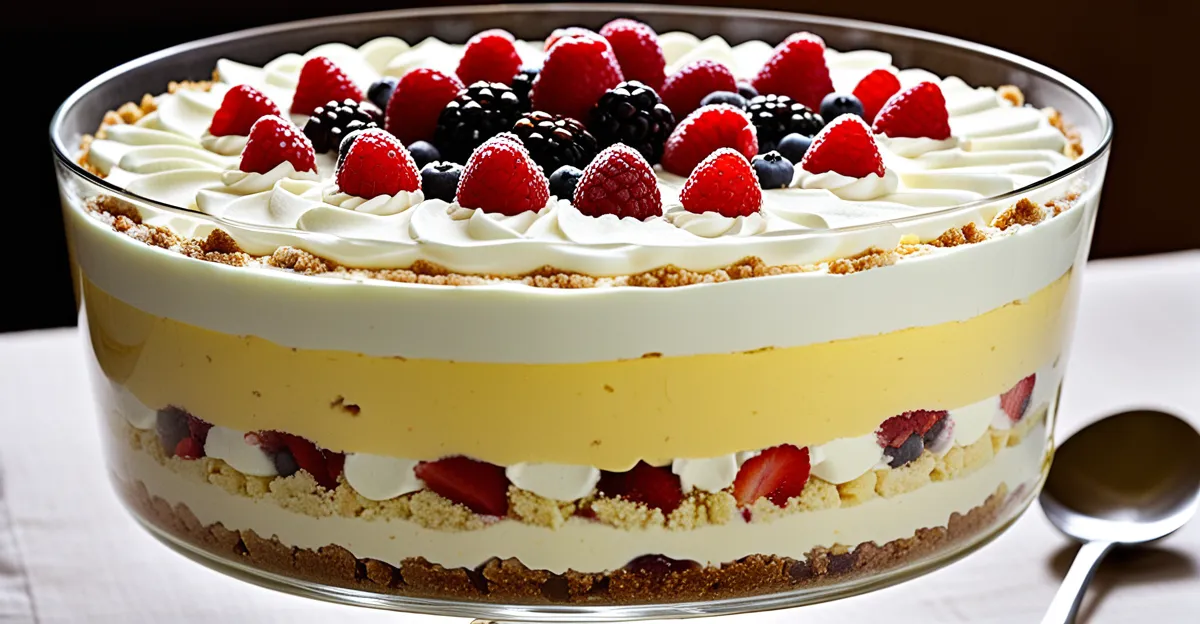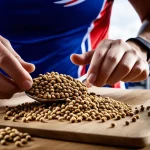Essential Ingredients and Tools for Traditional English Trifle
When crafting an authentic trifle dessert, using the right traditional English trifle ingredients is crucial. The foundation begins with a light sponge cake, often soaked in sherry or fruit juice to infuse moisture and flavour. Following the sponge, layers of fresh or preserved fruit add vibrant taste and texture; common choices include strawberries, raspberries, and peaches, which complement the jelly’s sweetness. The jelly itself, typically raspberry or strawberry-flavoured, must be prepared with care to maintain its set consistency without overpowering other components.
Equally important is the custard, a creamy layer that ties the trifle together. It should be made from scratch or chosen to provide a smooth, rich contrast to the jelly and sponge. Finally, a generous topping of whipped cream completes the dessert, lending lightness and decoration.
Topic to read : What’s the Secret to Perfecting Traditional British Recipes?
Regarding trifle dessert tools, having the proper equipment ensures ease and precision during preparation. A deep, clear glass bowl or trifle dish is essential for showcasing the dessert’s attractive layers. Additionally, a spatula for gentle spreading, a mixing bowl for whipping cream, and a saucepan for custard preparation are indispensable. For chopping fruit and slicing sponge cake, a sharp knife is necessary to maintain clean layers. These authentic trifle components and related tools form the backbone of a successful traditional English trifle, ensuring both authenticity and appeal.
Step-by-Step Guide to Preparing Each Trifle Component
Mastering English trifle preparation begins with carefully crafting each element to ensure harmony in texture and flavour. Start with the sponge cake base. For authenticity, soak the sponge in sherry or fruit juice, which keeps it moist and infuses a subtle boozy or fruity note. This step is crucial, as an improperly soaked sponge can lead to a dry or overly soggy foundation.
Have you seen this : What Are the Health Benefits of Eating Traditional UK Dishes?
Next, focus on making trifle jelly. Prepare the jelly using classic flavours like raspberry or strawberry, which are traditional English trifle ingredients. The jelly must be cooled until it starts to thicken but is not fully set before layering with fruit to prevent sinking. Mixing fresh or canned fruit with the jelly enhances flavour and simulates the authentic trifle components, locking in moisture and sweetness.
For the custard, following a reliable trifle custard recipe is vital. Homemade custard should be cooked slowly over low heat to avoid curdling, resulting in a smooth, creamy texture. It must cool completely before assembly to maintain distinct layers in the final dessert. Using quality ingredients—such as fresh eggs and real vanilla—elevates the custard’s taste, reinforcing the classic taste profile.
These preparation steps mesh traditional English trifle ingredients with precise techniques and the right trifle dessert tools,—like mixing bowls and saucepans—to create authentic trifle components that set the stage for an impressive layered dessert.
Assembling and Layering the Traditional English Trifle
Achieving the perfect traditional trifle layers begins with understanding the precise order and method of assembly. Start by arranging the soaked sponge cake base evenly at the bottom of a clear glass dish. This layer acts as the foundation, so ensuring it is well-distributed helps support subsequent layers while maintaining moisture balance.
After the sponge, pour or spoon the prepared fruit-jelly mixture across the surface. The making trifle jelly step must have been carefully cooled to a custard-like consistency to prevent fruit from sinking. Incorporating fresh or preserved fruit in this layer adds texture and natural sweetness, blending well with the jelly to form a cohesive middle layer.
Next, gently spread the custard, made from a trusted trifle custard recipe, over the jelly. This creamy layer acts as a smooth bridge between the jellied fruit and the final topping. It is essential to ensure the custard is fully cooled and thickened before layering to maintain clean, distinct layers without blending or weeping.
The final step before chilling is topping the trifle with a generous swathe of whipped cream. This not only adds lightness but also enhances the dessert’s visual appeal during trifle presentation. Once assembled, chilling the trifle for several hours allows the layers to set firmly and the flavours to meld, resulting in a balanced, traditional English trifle that’s both delicious and esthetically pleasing.
Key tips for how to assemble trifle include working with cooled components to prevent mixing and using a clear glass dish to showcase the artistry of layers. Gentle spreading tools like spatulas help maintain clean separations between layers, which is vital for an authentic and attractive final trifle.
Presentation, Serving Tips, and Authentic Variations
The final step in creating a traditional English trifle focuses on serving English trifle with tasteful presentation and subtle garnishing that enhance both appearance and flavour. After assembling the classic layers, a fresh layer of whipped cream is often added just before serving. This topping not only softens the dessert visually but also balances the texture with its light, airy consistency.
When considering trifle garnishes, common authentic additions include slivered almonds, grated chocolate, or fresh berries—each adding a slight contrast in texture or a pop of colour. These garnishes should be used sparingly to maintain the trifle’s traditional look while offering extended flavour complexity.
For trifle variations, regional and historical differences bring exciting twists to the classic recipe. Some versions incorporate different alcohols such as rum or brandy instead of sherry, providing a stronger flavour profile. Other variations might swap the jelly flavour or use seasonal fruits tailored to availability, preserving authenticity while adding variety. For celebratory occasions, layering in additional custard or cream varieties can elevate the dessert’s richness, catering perfectly to diverse palates.
Serving the trifle chilled is essential to allow layers to set firmly, ensuring a clean slice and optimal texture. Presenting the trifle in a clear glass dish showcases the distinctive traditional trifle layers, making it visually appealing at gatherings. Remember, neat layering and thoughtful garnishing elevate both the trifle’s look and enjoyment, reflecting the care taken throughout the English trifle preparation.






